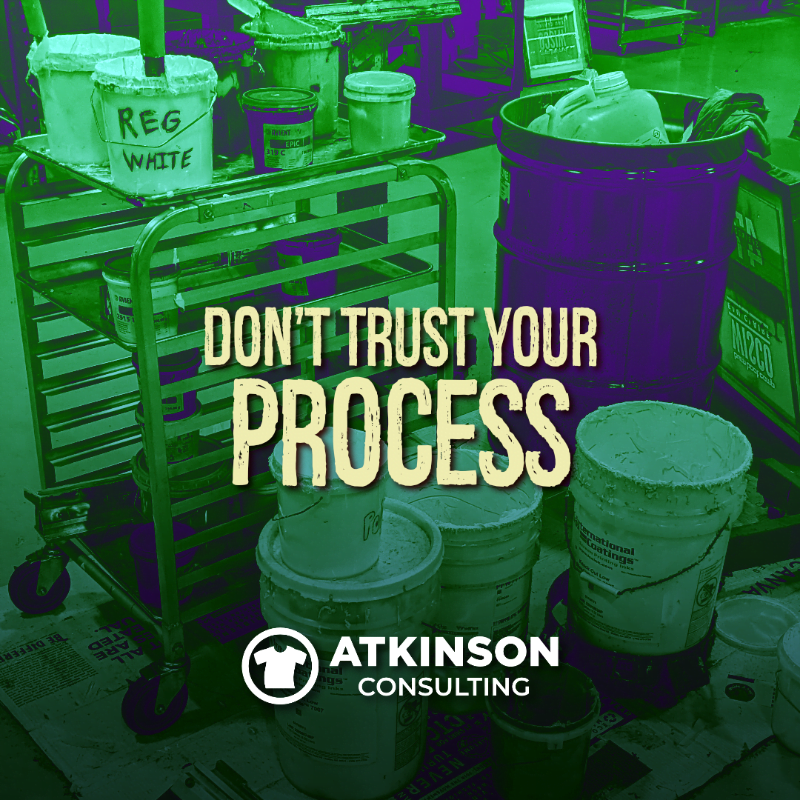Let’s talk about processes. First of all, do you have them? I mean, REALLY have them?
I don’t want to sound like I don’t believe you, but I have to come clean here…I keep bumping into shops that SAY they have processes. But after a few short minutes of conversation, it is obvious that something isn’t working correctly.
This is why I’m saying, “Don’t Trust Your Process.” Because just maybe you’ve got it all wrong.
And while we are at it, let’s also state that processes are not limited to production. Do you have a hiring process? Employee retention process? Sales and lead generation process? Maybe even an employee safety and hazard communication process?
As every shop is different, just simply answer this one question: What isn’t working the way it should?
Whatever that is, I’ll bet that the process (or lack of one) for that challenge needs improvement.
You Are In Luck
That’s right. This is what I do. Help with processes.
All it takes is a little work, and you can see an immediate improvement in whatever isn’t up to snuff.
First, Gather Information
The first thing you should do is gather information and benchmark where you are now. This is important.
After all, how can you know if something has been improved if you can’t compare it to the original condition?
Especially if your “process” is that you don’t actually have one. Or, are not actually following what you’ve built.
Here are a few information gathering tips:
- Use the camera on your phone. Take pictures or videos of how you do it now. Not just one or two. A whole album full. You might want to document over a few days too, as sometimes conditions change with orders, people, types of jobs, etc.
- Measure. How much time does it take? How many can you do in an hour or a shift? If you are using some materials or consumables, how much are you using?
- Talk to your team. What bothers them? Are they usually waiting on something? What could be improved? If you could buy something to improve their situation, what would they want?
- Look at training. Many times only one person knows how to do something. When things get backed up or that person isn’t working today, problems start accumulating. How many people are cross-trained in the process?
- Examine your equipment. Is it old? Are some functions with it not working as they should? Does it break down or freeze up and have to be restarted?
- Understand your consumables. Are you using them correctly? Often, there are manufacturers’ suggestions on how to use the product. Are they being followed?
- Understand how your environment plays a role. Temperature and humidity levels can play havoc with some processes. Are you controlling these? What are the ideal conditions for what you are trying to do? Are you within those tolerances? What problems occur when you are not?
This Initial Research is Crucial
I’ve helped streamline many shops, and this initial research is a crucial first step. You can’t offer up a remedy until you know what is wrong. Don’t start changing things until you have a firm grasp on the situation, otherwise, you could just make things worse.
Document from beginning to end everything. How is it being handled now?
Once you have a complete and robust grip on the challenge, then you can think about the next steps.
Where Are The Bottlenecks?
After you have spent a good amount of time observing and understanding the situation, the bottlenecks in the process should be apparent.
Remember, you can only move as fast as the slowest part of your process. What is that?
Usually, this means that someone is waiting on another person, department, or process to do their thing. Therefore, spend some time and solve what you are constantly waiting on.
Be more organized. Do things early. Make things so easy that it is really hard to screw them up.
Your job here is to identify the areas that need improvement. That is step two.
Map Out The New Change
Working with the team that will actually do the work, start mapping out the new process change. Don’t shove it down their throats. Instead, begin with the end in mind.
What do you want to achieve? “What if we do it this way?”, you may say.
Write it down. Go to the space and talk to the team. Get their input.
“If we change this, in order to save that, this is the result that should happen. What do you think?”
Team feedback is what you want here. In fact, if the challenge is big enough, you may consider bringing other people into the discussion. Your suppliers, customers, and industry colleagues all may suggest something that might have a positive impact on the situation.
The new information and feedback you get from this step will be the catalyst for the change you seek.
Fire Bullets Then Cannonballs
The next step is to test what you want to do. Start small.
Will your new idea actually work? Measure and record what you are doing. It is 100% ok if you fail. Don’t worry about it.
This is how you learn. And also why you are starting small. Don’t make something company-wide until you know that it is a proven, reliable process.
As you keep working and using the new process, tweak and change it until it meets your satisfaction and goals. Then, try to make it work to consistently improve the results.
By the way, your process has to work with anyone doing the task. If only Steve can do it, then what will happen if Steve isn’t working today?
Your process can’t be about which employee is doing the work. You want to train multiple people to have the bench strength and coverage for your process improvement idea.
Implement The New Process
After you have proven that the new process works and have multiple people trained on how to do it, it is time to implement it and solidify it within your company.
Start by documenting the new process. Take pictures or film footage. Write everything down. Make charts or graphs, and step-by-step action guidelines.
You want to make it easy for anyone to learn what to do, and how to do it correctly.
Then, begin to train new people. As you go, keep records of where people make mistakes or struggle. This is where you might need to focus some attention later.
Control the Process
What you want more than anything with the process are three things:
- Consistency. It has to work every time.
- Predictability. You know it will happen this way.
- Reliability. There are zero worries about it.
In your company right now, what processes do you have that are at this level? Payroll? Art creation? Shipping?
If something isn’t quite at this level, what will it take to have Consistency, Predictability, and Reliability? What you are searching for here is control. There have to be some guardrails in place to ensure the outcome.
This is how you get to the point where you actually Trust the Process.
If you don’t have that level of trust in your process, do the work to fix it. Don’t ignore it!
Wishing it would work won’t actually make the change that you need.
You can do this.
“We all have a tendency to avoid our weaknesses. When we do that, we never progress or get any better.” – Jocko Willink
“If you continue to keep low performers on your team, that are actually dragging the team down; you’re failing the whole team, and eventually, the whole team is going to fail.” – Jocko Willink
“If you get your ego in the way, you will only look to other people or circumstances to blame.” – Jocko Willink
Help Support This Blog

If you like this blog and would like to support it, you can:
- Buy a book.
- Share this blog on your social media.
- Join Shirt Lab Tribe.
- Subscribe to the Success Stories podcast.
- Watch and like an episode on the Jerzees Adventures in Apparel Decorating YouTube series.
- Get signed up for the new Production Tracker app.
Thanks!

Marshall Atkinson also shares exclusive blog content at Supacolor.com. Supacolor makes The World’s Best Heat Transfer and provides tips, inspiration, and other resources designed to empower professional garment printers.



